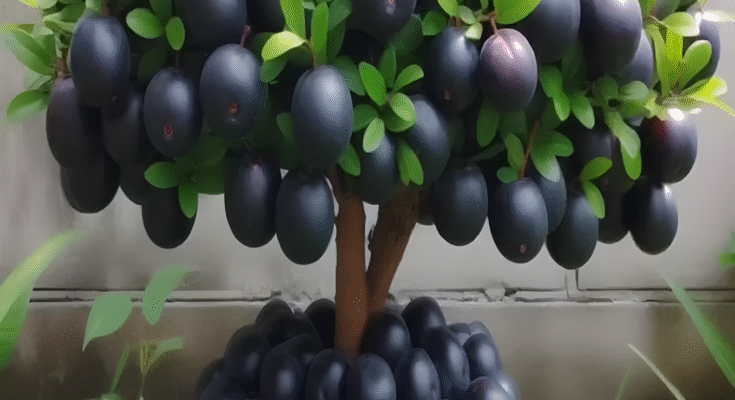Great Planting Skills to Harvest More Jamun or Black Plum
If you dream of harvesting baskets full of sweet, purple-black Jamun (also known as Black Plum or Java Plum), you need more than just good soil and sunshine — you need great planting skills and the right care techniques. Jamun is a tropical fruit native to India and Southeast Asia, prized for its unique taste and numerous health benefits. Whether you’re a backyard gardener or a small orchard grower, learning a few key methods can help you increase your yield dramatically.
Choosing the Right Variety and Location
Your success with Jamun starts with selecting the best variety for your region. Popular cultivars include ‘Ra Jamun’, ‘Paras’, and ‘Goma Priyanka’. These have larger fruits, better taste, and higher pulp content than wild varieties. Make sure you source saplings or seeds from a trusted nursery to ensure they are disease-free and true to type.
Jamun trees thrive in tropical to subtropical climates. They prefer full sun and can tolerate light shade but produce the best fruit in open sunlight. Choose a spot with deep, well-drained loamy soil. Jamun trees can grow in clay or sandy soil too, but you’ll get better yields if the soil is fertile and rich in organic matter.
Preparing the Land
Good land preparation sets the stage for healthy, productive trees. Clear weeds, stones, and debris from your chosen site. Dig pits of about 1 meter x 1 meter x 1 meter. Fill these pits with a mixture of topsoil, compost or well-rotted farmyard manure, and a bit of sand if the soil is heavy clay. This rich planting pit gives young trees a nutrient boost to establish strong roots.
If you’re planting multiple Jamun trees, maintain a spacing of at least 8–10 meters between each tree. This wide spacing allows sunlight to penetrate the canopy and good air circulation to prevent diseases.
Planting Techniques
Jamun can be grown from seeds, but it’s much better to use grafted or budded saplings for quicker fruiting and true-to-type plants. Seed-grown trees can take 8–10 years to bear fruit, while grafted trees may fruit in just 4–5 years.
When planting, place the sapling in the pit so that the root ball sits at ground level. Fill the pit gently with soil, pressing firmly but not compacting too hard. Water thoroughly to settle the soil around the roots.
It’s a good practice to provide support stakes for young saplings to protect them from strong winds and to keep them growing straight.
Watering and Mulching
Jamun trees are fairly hardy and drought-tolerant once established, but they need regular watering during the first few years to develop a strong root system. Water deeply once a week during dry periods. Avoid waterlogging — Jamun hates standing water.
Mulching around the base of the tree with dry leaves, straw, or compost helps retain soil moisture, regulate temperature, and suppress weeds. Keep the mulch a few inches away from the trunk to prevent rot.
Fertilizing for Better Yield
A balanced nutrition plan makes a big difference in fruit production. Apply well-rotted manure or compost every year during winter or early spring. For mature trees, supplement with organic or inorganic fertilizers rich in nitrogen, phosphorus, and potassium (NPK). A common dose is about 20–30 kg of compost and 1–2 kg of NPK mix per tree annually.
Micronutrients like zinc and boron can also improve flowering and fruit set. If you notice poor fruiting, a foliar spray of micronutrient mixture during flowering can help.
Pruning for Productivity
Pruning is one of the most overlooked planting skills but is vital for a good harvest. Jamun trees naturally grow tall with dense foliage. If left unpruned, the canopy becomes too thick, reducing light penetration and airflow.
After harvesting, prune the tree to remove dead, diseased, or crossing branches. Light thinning of inner branches lets sunlight reach all parts of the tree, encouraging more flowers and fruits. Shape the tree for a strong framework and easier harvesting.
Pest and Disease Management
Jamun trees are generally hardy but watch out for common pests like fruit flies, leaf-eating caterpillars, and aphids. Regular inspection helps you catch problems early. Neem oil spray or organic insecticides can control minor infestations.
For diseases like anthracnose or powdery mildew, ensure good air circulation and avoid waterlogging. Remove and destroy any infected fruits or branches to prevent spread.
Flowering and Fruit Care
Jamun trees usually flower from March to April, with fruits ready to harvest by June or July. Good pollination is key for a bumper crop. Bees and other insects help, so avoid using harmful chemical sprays during flowering.
When fruits are developing, provide steady moisture but avoid overwatering as it can cause fruit drop. If you have birds visiting your trees, use bird nets to protect ripening fruits.
Harvesting at the Right Time
Pick Jamun fruits when they turn deep purple-black and are slightly soft to the touch. They do not ripen much after picking, so harvest at full maturity for the best taste. Gently twist or cut the fruit from the cluster to avoid damaging the tree.
Conclusion
Growing Jamun or Black Plum can be very rewarding if you use the right planting skills and care methods. From selecting healthy saplings and preparing the soil to regular pruning and timely harvesting, each step plays an important role in boosting your yield. With patience and dedication, your Jamun trees will reward you year after year with baskets of delicious, nutritious fruits to enjoy fresh, in juices, or even preserved as tasty jams and jellies. So, roll up your sleeves, put these planting skills to work, and watch your Jamun harvest flourish!



